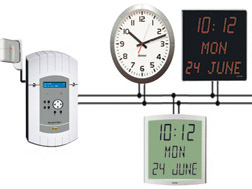 A master clock is a precision clock that provides timing signals to synchronise slave clocks as part of a clock network. Networks of electric clocks connected by wires to a precision master pendulum clock began to be used in institutions like factories, offices, and schools around 1900. Today many radio clocks are synchronised by radio signals or internet connections to a worldwide time system called Coordinated Universal Time (UTC) which is governed by master atomic clocks in many countries.
A master clock is a precision clock that provides timing signals to synchronise slave clocks as part of a clock network. Networks of electric clocks connected by wires to a precision master pendulum clock began to be used in institutions like factories, offices, and schools around 1900. Today many radio clocks are synchronised by radio signals or internet connections to a worldwide time system called Coordinated Universal Time (UTC) which is governed by master atomic clocks in many countries.
In the days before the availability of such highly accurate reference time many master clocks were an accurate electrically maintained pendulum clock. Thousands of such clocks were installed, in schools, offices, railway networks, telephone exchanges and factories all over the world; they resembled a longcase clock, but had a very robust mechanism and a less ornate case. The clock timing signals, generated by electrical contacts attached to the mechanism, were minute, half minute and sometimes one second electrical pulses, fed to the controlled equipment on pairs of wires. The devices driven could be wall clocks, tower clocks, factory sirens, school bells and occasionally clock chiming mechanisms. Some types, such as the Synchronome had optional extra mechanisms to compare the time of the clock with a standard received from the GPO time service which relayed the time signal from the Greenwich Observatory, which allowed small weights to be added or removed from the pendulum without interruption. Small weights could also be added or removed manually in the absence of this mechanism again without interruption.



